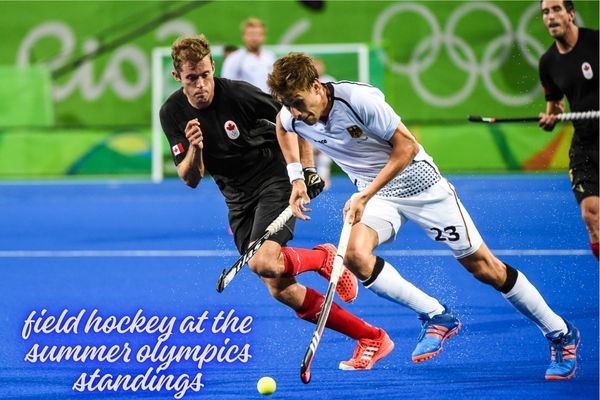Introduction: field hockey at the summer olympics standings
Field hockey has been a proud part of the Summer Olympics for decades. Known for its speed, strategy, and moments of pure passion, the sport has grown into one of the most anticipated Olympic events. From nail-biting finishes to heartwarming traditions, there’s more to field hockey than meets the eye. In this detailed look, we’ll explore Olympic standings, fascinating cultural quirks—referred to as “hibbies”—and all the details that make Olympic hockey special.
Table of Contents
A Look Back: Field Hockey’s Olympic Journey
The Early Years
Field hockey was first played in the 1908 London Olympics, but its inclusion wasn’t consistent until 1928, when the sport officially became a permanent part of the men’s program. Women had to wait until 1980, when they finally made their debut in the Moscow Olympics.
How the Game Evolved
The game has changed dramatically over the decades—from grass to synthetic turfs, from wooden sticks to modern carbon-fiber gear. Today’s Olympic hockey is faster, sharper, and far more technical than ever before. These upgrades have made the sport more thrilling for viewers and more competitive for teams.
Countries That Shine in Olympic Hockey
Some nations have left a lasting legacy on the Olympic hockey stage. Let’s look at a few of the sport’s heavyweights.
India
India once ruled Olympic hockey. Between 1928 and 1980, the Indian men’s team bagged eight gold medals, including an unmatched streak of six consecutive wins. Their fluid style and ball control wowed the world.
Netherlands
The Dutch have become giants, particularly in women’s hockey. The Netherlands women’s team has dominated recent editions, known for their technical excellence and consistent performances.
Australia
Australia’s Kookaburras (men) and Hockeyroos (women) have been global forces. The men won gold in 2004, while the women dominated during the late 1990s and early 2000s, winning multiple Olympic titles.
Germany
Germany has always been a tactical powerhouse. With strong showings from both men and women, they’re known for discipline, efficiency, and big-match temperament.
2024 Olympic Standings: Who’s on Top?
The Paris 2024 Summer Olympics brought fierce competition, with close matches and standout performances.
Men’s Hockey Standings – Paris 2024
| Position | Team | Wins | Draws | Losses | Points |
|---|---|---|---|---|---|
| 1 | Netherlands | 4 | 1 | 0 | 13 |
| 2 | Germany | 3 | 1 | 1 | 10 |
| 3 | India | 3 | 0 | 2 | 9 |
| 4 | Australia | 2 | 1 | 2 | 7 |
| 5 | Belgium | 1 | 1 | 3 | 4 |
| 6 | Argentina | 0 | 0 | 5 | 0 |
Women’s Hockey Standings – Paris 2024
| Position | Team | Wins | Draws | Losses | Points |
|---|---|---|---|---|---|
| 1 | Netherlands | 5 | 0 | 0 | 15 |
| 2 | Australia | 4 | 0 | 1 | 12 |
| 3 | Germany | 3 | 1 | 1 | 10 |
| 4 | India | 2 | 1 | 2 | 7 |
| 5 | Great Britain | 1 | 0 | 4 | 3 |
| 6 | Spain | 0 | 0 | 5 | 0 |
These are group stage standings, which determined who progressed to the knockout rounds.
What Are Hibbies? Unique Traditions in Olympic Hockey
“Hibbies” is a term we’re using to describe the rituals, quirks, and customs that make field hockey at the Olympics even more interesting.
Pre-Match Superstitions
Athletes are creatures of habit. Some players always wear the same wristband or step on the pitch with their right foot first. Others listen to the same pump-up song before every game.
Team Mascots and Lucky Charms
- India often carries a symbolic item like the Ashoka Chakra.
- The Australian Kookaburras have a plush mascot that travels everywhere with the team.
- Dutch players wear orange socks for unity and spirit.
Victory Dances and Flag Celebrations
After big wins, it’s common to see teams performing choreographed dances with their national flags. These joyful moments have become Olympic fan favorites.
Hockey Stick Tributes
Some teams raise their sticks toward the sky after the final whistle to honor past players or dedicate the win to their country’s fans. It’s emotional and deeply symbolic.
Iconic Olympic Moments in Hockey
India’s Golden Reign
Between 1928 and 1956, India dominated. Their 1964 gold in Tokyo was especially sweet, coming after a shocking defeat to Pakistan in 1960.
Zimbabwe’s Unexpected Glory – 1980
When many teams withdrew from the 1980 Games, Zimbabwe’s women’s team was called in at the last minute. They went on to win gold, making it one of the most inspiring Olympic stories.
Germany’s Redemption – 2012
Germany’s men bounced back in London 2012, overcoming injuries and pressure to retain their title. It was a masterclass in teamwork and focus.
How the Olympic Field Hockey Tournament Works
Format Overview
Teams are divided into two pools, with each team playing everyone in their group. The top four teams from each group move on to the quarterfinals.
Points System
- Win = 3 points
- Draw = 1 point
- Loss = 0 points
Knockout and Finals
The quarterfinals lead into semifinals, followed by the bronze medal match and the gold medal final. If a knockout match is tied, it’s decided by a penalty shootout.
Women’s Hockey: Rising and Thriving
Women’s field hockey has come a long way since 1980. Today, it’s just as competitive and thrilling as the men’s tournament.
The Rise of India’s Women’s Team
The Indian women’s team’s journey to the semifinals in Tokyo 2020 was one of the highlights of the tournament. Though they narrowly missed a medal, their determination earned worldwide respect.
Dominance of the Dutch
The Netherlands women continue to set the bar, with technically brilliant play and unmatched consistency. They’re currently the gold standard.
Equipment and Innovation in Olympic Hockey
Gear and Uniforms
Sticks are now made from advanced carbon fiber for power and control. Players also wear protective gear like mouthguards, shin pads, and gloves.
Smart Turf
Modern hockey at the Olympics is played on water-based artificial turf, which offers speed and safety. Paris 2024 introduced eco-friendly turfs to support sustainability.
Video Assistance
Teams can request video referrals to challenge umpire decisions. It’s a high-stakes move, as you only get one per game.
What Makes Field Hockey Special at the Olympics?
Sportsmanship and Respect
Despite being a high-stakes sport, field hockey is known for its fair play. You’ll often see players hug or exchange jerseys after tough matches.
Representation and Equality
Both men’s and women’s tournaments enjoy equal attention, reflecting the Olympics’ push for gender equality in sports.
Global Spirit
From African debutants to Asian dynamos and European powerhouses, field hockey brings together a diverse mix of cultures and styles.
Breakout Stars of Paris 2024
Vivek Sagar Prasad (India)
A midfield engine, Vivek’s control and passing set the rhythm for India’s game. He’s one of the brightest young talents on the field.
Frédérique Matla (Netherlands)
Sharp, skillful, and always in the right place, Matla has become one of the most feared forwards in women’s hockey.
Blake Govers (Australia)
Known for his explosive drag flicks, Govers is a scoring machine and a crowd favorite.
The Future of Olympic Hockey
Bigger Global Reach
There’s a push to grow the sport in regions like Africa and South America, and include more nations in the main draw.
Mixed-Gender Showcases?
While not official yet, mixed exhibition matches have been proposed to celebrate equality and offer new formats.
Tech and Engagement
Future editions may use AR/VR, advanced statistics, and fan interaction tools to take Olympic hockey into the digital age.
Final Thoughts
Field hockey at the Summer Olympics remains one of the most thrilling and historic sporting events. From unforgettable moments and exciting standings to traditions, superstitions, and hibbies that add charm, it’s a celebration of sport, strategy, and spirit. As we look forward to future Olympics, one thing is certain: the passion for field hockey is only growing stronger.



